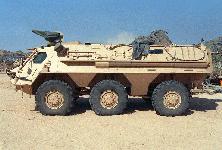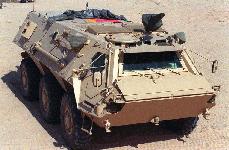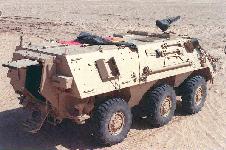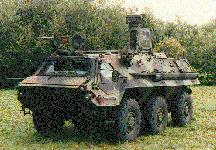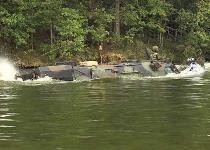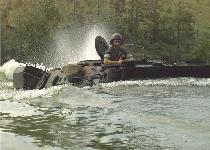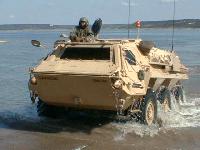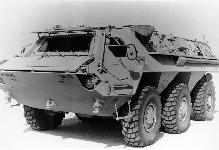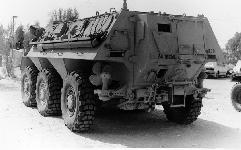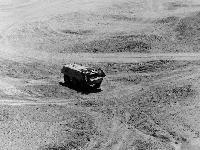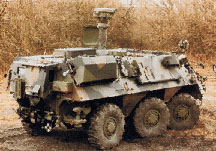 The FOX is a rolling laboratory that takes air, water, and ground samples and immediately analyzes them for signs of weapons of mass destruction.
The Fox M93A1 Nuclear, Biological, and Chemical Reconnaissance System (NBCRS)
is intended to improve the survivability and mobility of the
Army ground forces by providing increased situational awareness and information
superiority to headquarters and combat maneuver elements. With the ability to
provide rapid, accurate chemical and radiological contamination information to these
elements, the NBCRS vehicle forms a key portion of the full-dimensional
protection concept.
The mission of the lightly-armored, wheeled NBCRS is to detect, identify, mark,
sample, and report chemical and radiological contamination on the battlefield. The
three-man NBCRS crew accomplishes these missions by using a sophisticated suite
of nuclear and chemical alarms and detectors that have been integrated within the
vehicle chassis. The on-board M21 Remote Sensing Chemical Agent Alarm allows
the crew to detect chemical agent clouds as far as 5 kilometers away. The crew can
perform chemical and radiological reconnaissance operations while operating in a
shirt-sleeve environment inside the NBCRS vehicle, even while the vehicle is
operating in a contaminated area. During normal vehicle operations, there is no need
for the crew to wear chemical protective gear or masks.
NBC defense encompasses three major functions: contamination avoidance, protection, and decontamination. Contamination avoidance is the concept of avoiding contamination whenever possible and is the focal point of our NBC
defense doctrine. It enables units to operate without incurring the degradation caused by individual or collective protection and time, labor, and logistics intensive decontamination operations. When it is not possible to avoid contamination, the spread of contamination is limited so that it presents the minimum possible hazard to personnel, has the minimum impact on operations, and allows the rapid resumption of normal operations. Contamination avoidance explicitly includes NBC reconnaissance, detection, sampling, identification, and warning. The NBCRS is a key system used to perform these functions.
Units and soldiers must be aware of NBC hazards within their area of concern. Both the presence and absence of NBC hazards is of interest. When NBC hazards are located, they must be marked on a near-real time basis. This allows units to avoid the hazard, or to protect themselves in order to minimize casualties if they cannot avoid it. Commanders must also be made aware of the absence of NBC hazards in their areas of immediate operational concern. This allows them to lower their protective posture and minimize degradation. Samples of unidentified contaminants must be collected and
evacuated for laboratory analysis in order to maintain a current understanding of enemy capabilities and their impact.
In the Main Battle Area, the NBCRS supports the forces behind the direct fire battle. In the direct fire battle, lines between forces are indistinct and change rapidly. The enemy is unlikely to employ NBC weapons in this area to avoid their effects on its own units, and the battle is too intense and fast-moving for NBC reconnaissance to be effective in detecting contamination from previous strikes. Additionally, lightly armored systems such as the NBCRS are not very survivable in this area, and a low density, high payoff system like the NBCRS should not be put at such a risk.
Immediately behind the direct fire battle, the NBCRS supports AirLand Battle doctrine by enabling the unhindered forward or lateral movement of reserve and counter-attack units, thus enhancing the force�s agility, retaining depth, and preventing the disruption of synchronization. It gives the commander the ability to �see� the contaminated battlefield better than the enemy, providing him an advantage in seizing and keeping the initiative.
Further to the rear, the NBCRS supports the unhindered forward movement of reinforcing units, finds �clean� main supply routes, and supports the mobility of command and control and logistical organizations, further enhancing depth.
NBC contamination information collected by the NBCRS is provided to command and control systems in real time to aid in NBC battle management, allowing commanders to obtain the NBC picture and maintain the required operational tempo. NBC reconnaissance applies to low-intensity conflict situations to reduce vulnerability to insurgent and/or terrorist use of chemical or biological weapons. Forces will be provided an NBC threat assessment for potential theaters of operations. Forces deploy with and use a tailored force protection package for NBC defense.
Surveillance/silent watch is conducted when the NBCRS locates at a given position for an extended period of time (hours) and uses its stand-off detection capabilities. In this role, the NBCRS is observing critical unoccupied terrain for evidence of NBC activity. Additionally, the NBCRS can augment existing detection capabilities and scan upwind of a unit,
this is called unit defense. The objective of unit defense is to provide additional NBC warning time to high priority units. The emphasis is on the early detection of vapor hazards. During surveillance, such activities as sleeping, eating, and performing PMCS can be accomplished on a rotation basis between the crew.
The NBCRS detects and identifies nuclear and chemical contamination. It warns units of NBC contamination, reports the location of NBC hazards, marks areas of contamination, locates and marks clean bypass routes,
and collects and transports samples of NBC materiel for later analysis. The NBCRS accomplishes these functions by performing the following missions:
The FOX is a rolling laboratory that takes air, water, and ground samples and immediately analyzes them for signs of weapons of mass destruction.
The Fox M93A1 Nuclear, Biological, and Chemical Reconnaissance System (NBCRS)
is intended to improve the survivability and mobility of the
Army ground forces by providing increased situational awareness and information
superiority to headquarters and combat maneuver elements. With the ability to
provide rapid, accurate chemical and radiological contamination information to these
elements, the NBCRS vehicle forms a key portion of the full-dimensional
protection concept.
The mission of the lightly-armored, wheeled NBCRS is to detect, identify, mark,
sample, and report chemical and radiological contamination on the battlefield. The
three-man NBCRS crew accomplishes these missions by using a sophisticated suite
of nuclear and chemical alarms and detectors that have been integrated within the
vehicle chassis. The on-board M21 Remote Sensing Chemical Agent Alarm allows
the crew to detect chemical agent clouds as far as 5 kilometers away. The crew can
perform chemical and radiological reconnaissance operations while operating in a
shirt-sleeve environment inside the NBCRS vehicle, even while the vehicle is
operating in a contaminated area. During normal vehicle operations, there is no need
for the crew to wear chemical protective gear or masks.
NBC defense encompasses three major functions: contamination avoidance, protection, and decontamination. Contamination avoidance is the concept of avoiding contamination whenever possible and is the focal point of our NBC
defense doctrine. It enables units to operate without incurring the degradation caused by individual or collective protection and time, labor, and logistics intensive decontamination operations. When it is not possible to avoid contamination, the spread of contamination is limited so that it presents the minimum possible hazard to personnel, has the minimum impact on operations, and allows the rapid resumption of normal operations. Contamination avoidance explicitly includes NBC reconnaissance, detection, sampling, identification, and warning. The NBCRS is a key system used to perform these functions.
Units and soldiers must be aware of NBC hazards within their area of concern. Both the presence and absence of NBC hazards is of interest. When NBC hazards are located, they must be marked on a near-real time basis. This allows units to avoid the hazard, or to protect themselves in order to minimize casualties if they cannot avoid it. Commanders must also be made aware of the absence of NBC hazards in their areas of immediate operational concern. This allows them to lower their protective posture and minimize degradation. Samples of unidentified contaminants must be collected and
evacuated for laboratory analysis in order to maintain a current understanding of enemy capabilities and their impact.
In the Main Battle Area, the NBCRS supports the forces behind the direct fire battle. In the direct fire battle, lines between forces are indistinct and change rapidly. The enemy is unlikely to employ NBC weapons in this area to avoid their effects on its own units, and the battle is too intense and fast-moving for NBC reconnaissance to be effective in detecting contamination from previous strikes. Additionally, lightly armored systems such as the NBCRS are not very survivable in this area, and a low density, high payoff system like the NBCRS should not be put at such a risk.
Immediately behind the direct fire battle, the NBCRS supports AirLand Battle doctrine by enabling the unhindered forward or lateral movement of reserve and counter-attack units, thus enhancing the force�s agility, retaining depth, and preventing the disruption of synchronization. It gives the commander the ability to �see� the contaminated battlefield better than the enemy, providing him an advantage in seizing and keeping the initiative.
Further to the rear, the NBCRS supports the unhindered forward movement of reinforcing units, finds �clean� main supply routes, and supports the mobility of command and control and logistical organizations, further enhancing depth.
NBC contamination information collected by the NBCRS is provided to command and control systems in real time to aid in NBC battle management, allowing commanders to obtain the NBC picture and maintain the required operational tempo. NBC reconnaissance applies to low-intensity conflict situations to reduce vulnerability to insurgent and/or terrorist use of chemical or biological weapons. Forces will be provided an NBC threat assessment for potential theaters of operations. Forces deploy with and use a tailored force protection package for NBC defense.
Surveillance/silent watch is conducted when the NBCRS locates at a given position for an extended period of time (hours) and uses its stand-off detection capabilities. In this role, the NBCRS is observing critical unoccupied terrain for evidence of NBC activity. Additionally, the NBCRS can augment existing detection capabilities and scan upwind of a unit,
this is called unit defense. The objective of unit defense is to provide additional NBC warning time to high priority units. The emphasis is on the early detection of vapor hazards. During surveillance, such activities as sleeping, eating, and performing PMCS can be accomplished on a rotation basis between the crew.
The NBCRS detects and identifies nuclear and chemical contamination. It warns units of NBC contamination, reports the location of NBC hazards, marks areas of contamination, locates and marks clean bypass routes,
and collects and transports samples of NBC materiel for later analysis. The NBCRS accomplishes these functions by performing the following missions:
- ce. Route reconnaissance obtains information as to the presence or absence of NBC contamination on a specified route and all adjacent terrain. The emphasis is on persistent NBC hazards along the route.
- Area reconnaissance is conducted when a commander needs information on the presence or absence of NBC hazards in a specified area, such as a proposed forward area rearming and refueling point for helicopters, or a proposed area for maneuver operations. The emphasis is on persistent NBC hazards within the area.
- Zone reconnaissance is a detailed, thorough, and time consuming NBC reconnaissance of all dominant terrain within specified boundaries. The emphasis is on persistent NBC hazards within the zone.
The Block 1 improvement was initiated to meet the requirements of the approved Required Operational Capabilities document, to provide organic maintenance, and to reduce the crew size to three. The improvement also incorporates fixes from the Pre-Production Qualification Test and the Initial Operational Test and Evaluation that make the system more user friendly and improve maintainability.
To meet the requirements of the Required Operational Capabilities document, additional hardware was added to the FOX. A mount was developed for the M21 Alarm that allows 180-degree rotation and leveling. A meteorological sensor measures wind speed, direction, air and ground temperature, and relative humidity while the vehicle is stopped. A central computer integrates the sensors and, when there is an alarm, automatically formats an NBC4 report for transmission. After reviewing the message on the display, the vehicle commander digitally transmits it through the SINCGARS radio.
To enhance operation by the three-man crew, a global positioning system was provided for the commander and the driver. Warning lights for the M21 Alarm and the sampling wheels were added to the dashboard. A monitor is provided to the commander which displays, on command, either the MM-1 mass spectrometer's screen or the picture from the M21 Alarm's aiming camera. A monitor and keypad for the mass spectrometer were added at the rear seat for the surveyor, allowing operation of the mass spectrometer from either seat in the rear.
Technical manuals for the operator and organizational maintenance were developed and tested during the Initial Operational Test and Evaluation. We also negotiated an International Agreement with Germany to procure common spare and repair parts and depot overhaul of major assemblies. When the M93A1 FOX is fielded, contractor logistic support will be used for all supply support and maintenance above organizational level.
The M93A1 increases the operational effectiveness of the FOX system and will serve the Chemical Corps and the Army well into the next century. Significant cost savings will be realized in the reduced crew size and the elimination of contractor maintenance and supply support.
Army ACAT III Program95 systems
Total program cost (TY$) $226M
Average unit cost (TY$) $2M
Full-rate Production 4QFY96
Prime Contractor
General Dynamics Land Systems
Thyssen Henschel (Germany)
Requirement Document: February 1991
NSN: 6665-01-372-1303
Block 1 Modification Type Classification: June 1995
Approved for production and fielding: FY95
Begin Production: FY96
New Materiel Release: FY98
First Unit Equipped: FY98
- Basis of Issue:
- 6 per Heavy Division Chemical Company
6 per ACR Chemical Company
36 per Corps, TAACOM NBC Reconnaissance Company
1 per Separate Brigade



